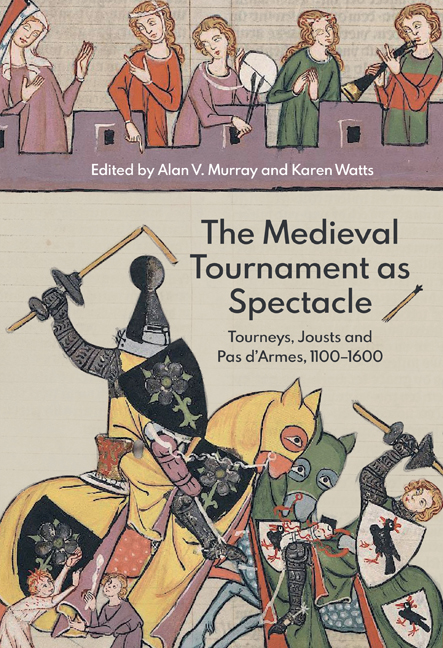Book contents
- Frontmatter
- Contents
- List of Illustrations
- List of Contributors
- Preface and Acknowledgements
- Introduction: From Mass Combat to Field of Cloth of Gold
- Research on the Medieval Tournament (1100–1600): A Select Bibliography
- 1 Now Form Up Close Together! Tactics and Ethos of the Tourney in Early German Sources (Twelfth to Thirteenth Centuries)
- 2 Por pris et por enor: Ideas of Honour as Reflected in the Medieval Tournament
- 3 Richard II of England and the Smithfield Tournament of October 1390: An Instrument to Establish Royal Authority
- 4 Alle myn harneys for the justes: Documents as a Source for Medieval Jousting Armour
- 5 The Tournament Saddle
- 6 Between Sport and Theatre: How Spectacular was the Pas d’armes?
- 7 Art Imitating Life Imitating Art? Representations of the Pas d’armes in Burgundian Prose Romance: The Case of Jehan d’Avennes
- 8 The Foot Combat as Tournament Event: Equipment, Space and Forms
- 9 Power and Pageantry: The Tournament at the Court of Maximilian I
- 10 The Field of Cloth of Gold: Arms, Armour and the Sporting Prowess of King Henry VIII and King Francis I
- Appendix 1 Calendar of the Royal Combats at the Field of Cloth of Gold, June 1520
- Appendix 2 Articles for the Challenge: The Emprise
- Index of Objects
- Index of Manuscripts
- General Index
8 - The Foot Combat as Tournament Event: Equipment, Space and Forms
Published online by Cambridge University Press: 11 September 2020
- Frontmatter
- Contents
- List of Illustrations
- List of Contributors
- Preface and Acknowledgements
- Introduction: From Mass Combat to Field of Cloth of Gold
- Research on the Medieval Tournament (1100–1600): A Select Bibliography
- 1 Now Form Up Close Together! Tactics and Ethos of the Tourney in Early German Sources (Twelfth to Thirteenth Centuries)
- 2 Por pris et por enor: Ideas of Honour as Reflected in the Medieval Tournament
- 3 Richard II of England and the Smithfield Tournament of October 1390: An Instrument to Establish Royal Authority
- 4 Alle myn harneys for the justes: Documents as a Source for Medieval Jousting Armour
- 5 The Tournament Saddle
- 6 Between Sport and Theatre: How Spectacular was the Pas d’armes?
- 7 Art Imitating Life Imitating Art? Representations of the Pas d’armes in Burgundian Prose Romance: The Case of Jehan d’Avennes
- 8 The Foot Combat as Tournament Event: Equipment, Space and Forms
- 9 Power and Pageantry: The Tournament at the Court of Maximilian I
- 10 The Field of Cloth of Gold: Arms, Armour and the Sporting Prowess of King Henry VIII and King Francis I
- Appendix 1 Calendar of the Royal Combats at the Field of Cloth of Gold, June 1520
- Appendix 2 Articles for the Challenge: The Emprise
- Index of Objects
- Index of Manuscripts
- General Index
Summary
In the fifteenth and sixteenth centuries, foot combat became an often popular event in tournaments, with notable monarchs of the period participating in and excelling at it. In contrast with jousting and its variations (which were more widely practised, and seen as more prestigious than foot combat), and other forms of mounted competitions, there has been little dedicated research on the various aspects and details of foot combat. This situation is understandable considering the dearth of sources on foot combat competitions compared with the other forms of events of the tournament, as well as the lack of consistency in those sources. Fighting ‘at the barriers’ as a synonym for foot combat works in the same manner as ‘the lists’ is used to refer to mounted competitions. In the case of foot combat, the barrier refers to the format of the competition that became popular in the sixteenth century, where contestants fought with various weapons over a separating construction. The popularity of foot combat tournaments coincided with (and was most likely affected by) changes and transitions in martial culture which also had an impact in the conduct of war as well as with the development of martial culture in civic environments with the introduction and increasing popularity of fencing guilds that in their own turn would hold their own competitions.
It is difficult to trace the precise origin or purpose of foot combat competitions because they included many other aspects of the medieval tournament: practice for war, combat sport and spectacle. In the study of foot combat competitions, the comparison with jousting is inevitable. While the latter can be seen as a measure of the prowess of a martial elite which reflects the use of cavalry in military contexts, the former is an expression of core martial skills associated with infantry warfare. This approach is what may lead one to depict foot combat as less chivalric but this is not necessarily true. The deeds in challenges of foot combat of famous knights such as Jacques Lalaing, Richard Beauchamp, earl of Warwick, and many more were already celebrated by the end of the fifteenth century. Accounts from throughout the fifteenth century give examples of pas d’armes, challenges and judicial duels between knights fought on foot.
- Type
- Chapter
- Information
- The Medieval Tournament as SpectacleTourneys, Jousts and Pas d'Armes, 1100-1600, pp. 155 - 184Publisher: Boydell & BrewerPrint publication year: 2020

